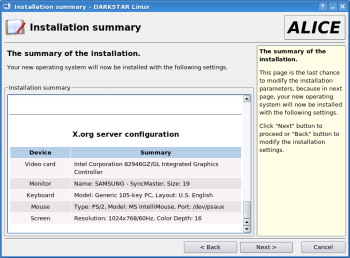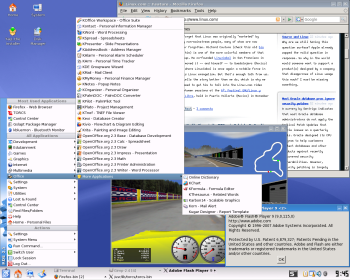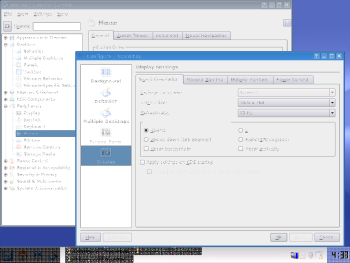Author: Mayank Sharma
Darkstar Linux 2008.1 is one of the first stable distro releases of the year. This distribution from Romania is based on Slackware and is available as a DVD image. For a desktop-oriented distro with its first release in 2004, Darkstar Linux has a lot of scope for improvement; its rock-solid performance and range of applications is overshadowed by its poor hardware skills.
According to its release announcement, Darkstar 2008.1 is designed as a desktop distro for new Linux users. The release is a big jump up from the distro’s debut release in 2004 as a two-CD distro. Darkstar 2008.1 packs a lot more applications, including a set of custom graphical configuration tools together known as Advanced Linux Installation and Configuration Environment (ALICE).
ALICE includes seven components for configuring various parts of a Darkstar distro, from preparing the disk for installation, to setting up the X server, to the actual installation. You can run the distro as a live DVD and install from within the live environment, or directly boot into the installer.
Despite being a DVD distro, Darkstar 2008.1 packs only the KDE desktop environment and the lightweight Xfce but no GNOME. But for every other category of software, Darkstar has a multitude of options. The distro packs two office suites (OpenOffice.org and KOffice), two popular media players (xine and MPlayer and their respective front ends, KMPlayer and gxine), the Firefox Web browser, and the Thunderbird email client, as well as the Mozilla Seamonkey Internet suite. Also bundled are lots of 3-D games, from racing simulators to first person shooters to educational games and games for kids. Not to mention the whole gamut of KDE apps and everyday apps like instant messaging and torrent clients, CD burners, and image editors.
Darkstar Linux is the most stable live DVD environment that I’ve seen. Even after hours of running the distro from RAM on a 2.0GHz E4400 dual-core desktop with 1GB of RAM, it never complained. I “stress-tested” it by launching heavy-duty apps like OpenOffice.org, the GIMP, Firefox, KOffice, TORCS, and more in quick succession, while leaving unsaved documents, lots of terminal emulators, and games running in the background for several hours, without any application crashing. I mounted external drives and copied about 10GB of ISO images to and from the computer without a hiccup from the live DVD.
In terms of hardware, Darkstar correctly configured my 1280×1024-pixel 17-inch monitor, and configured the wired network card via DHCP. But when I moved to another dual-core 1.8GHz E6300 computer, Darkstar couldn’t boot, failing to detect the DVD drive. This is a problem with older kernels, thanks to a previously unsupported IDE controller on the Intel DG965RY motherboard. Since Darkstar is based on Slackware, I assumed the problem to be with the old Slackware kernel. But Darkstar packs a customized kernel (2.6.23.8-desktop) which was released in November.
I was further disappointed when Darkstar failed to run on my old 1.3GHz Celeron laptop, rendering an unreadable desktop (see screenshot). It also failed to configure the PCMCIA wireless adapter, but I couldn’t troubleshoot that problem due to the rendering issues.
Darkstar leaves package management to Gslapt, which is an apt-get-like dependency-resolving tool for Slackware. It’s equipped with a custom Darkstar repository, but as of mid-January the repository had no new updates to be installed, which is strange considering that some everyday applications, such as Firefox, have had two releases since the one included in the distro.
Speaking of Firefox, the browser lacks plugins to play Flash videos, but includes the MPlayer browser integration plugin that plays media files inside the browser. I downloaded the Flash player package from Linuxpackages.net for Slackware 12, which bundles both the standalone Flash player and the browser plugin. It installed without any issues via the Slackware command-line installpkg tool. I’m used to the Ctrl-Tab key combination to move between tabs in Firefox. In Darkstar this key combination is set to switch virtual desktops, which is strange since there is just one virtual desktop in the live DVD environment!
The distro has associations for standard extensions of common formats like documents, images, video, and audio. But it lacks associations for slightly exotic files like .flv despite the fact that the bundled MPlayer application plays these files perfectly. Also, gxine didn’t start due to an error while loading the libmozjs.so shared library. But xine, MPlayer, and KMPlayer all work. I used them to play DVDs, CDs, and some AVI, MP4, MP3, OGG, and FLV files, as well as Real’s RM files, and 3GP clips from my cell phone. I did have to manually start KMix, which failed to start when the desktop loaded.
In addition to gxine, KDE’s Bluetooth utilities, such as kbluemon, failed to start, saying the error “is normally a bug in some application using the D-Bus library. D-Bus not built with -rdynamic so unable to print a backtrace.” Also Darkstar failed to mount USB devices when they were plugged in, despite a well-known solution to this Slackware issue.
It looks like the developers put in lots of effort into adding apps and utilities to the distro. When most major distros are focusing their efforts on making things easier for newbies to configure, Darkstar packs nothing more than the stock KDE Control Center and its configuration tools.
Of course the distro does have a custom installer in ALICE. While it makes things easier for new users, even this crucial component, which is one of the highlights of the distro, has some rough edges. First, when installing from within the live environment, you cannot resize the installer window. You have to use the scroll bars to read the instructions in the side column even if you have the screen space to fit the entire window. Also, since the developers are not native English-speakers, the instructions have lots of grammatical mistakes. Finally, in the user account section, the tab key behaves strangely. When you want to use it to skip to the next field, it jumps to the previous one.
Despite its flaws, I am running Darkstar on one of my desktops due to its wide range of apps and rock-solid performance. But I can’t recommend downloading a distro that fails to run on two other computers that have run everything from Gentoo to Ubuntu. The developers will have to dissect the distro’s hardware detection problems and actively maintain their software repositories before any more releases, if they want to compete with other desktop distros.
Categories:
- Darkstar
- Reviews
- Linux
- Distributions





